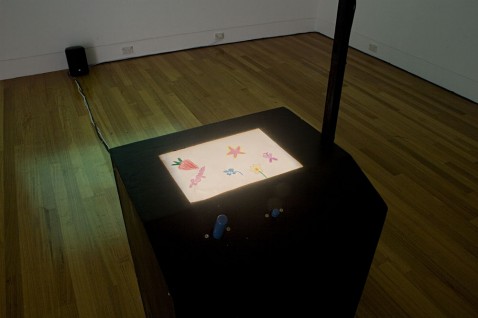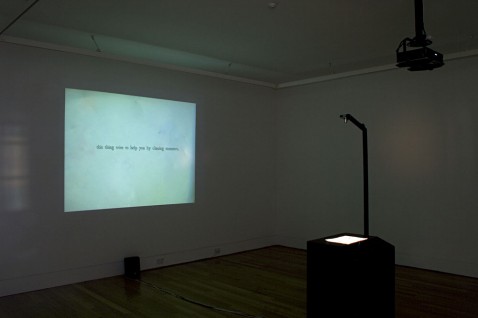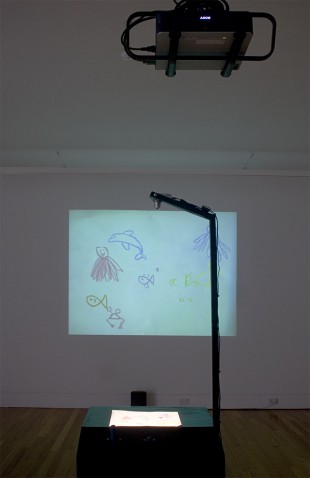
images courtesy of Te Tuhi Centre for the Arts. Above: a picture placed upon the machine; below: the machine explaining a game; bottom: a game in action (though the player seems to have left).

Note: This page is about the exhibit, not the free software project. If you are interested in using or developing the program, visit the code page.
Overview
Te Tuhi Video Game Machine was built for, and exhibited at, Te Tuhi Centre for the Arts, in Manukau City, New Zealand. The machine turns pictures drawn by gallery visitors into video games, which can be played immediately. It tends to make 2D, birds eye view games involving pursuit, consumption, evasion and occasionally shooting. Almost any picture can be turned into a game, but some will be boring or unplayable.
Using the video game machine
First you draw a picture (on paper) of the game you want to play. It is usually best to keep the characters separate from each other, and not draw too much background. If you draw background or frames or writes labels the machine will probably think these bits are game characters and make them squirm around.
You put the picture on top of the machine, which takes a photo.
After a few seconds, the computer will describe the game to you, explaining the rules and telling you what role each piece has. Some games have magic food in them that alters the rules of the game as it is played. You have to pay attention to these instructions, because the game might not turn out as you expected—for example, a figure you drew to be a helpful ally might turn out to be a nasty monster, or vice versa.
You play the game. If it is a good game, you can replay it as often as you like. A few seconds after you stop the machine will forget your game and wait for the next picture.
How it works
The machine splits the image into constituent parts, which it sorts into teams based on some kind of similarity. There will always be one team of one, which is destined to be your character. If there are not many image parts then each might be in its own team, but this is rare.
The machine concocts arbitrary rules for the behaviour and interaction of teams, and sets up agents to think on behalf of each image part, including the one that is you. It then plays the game by itself, at high speed, to see what will happen. If the game ends too quickly, or seems like it will never end, the rules are randomly adjusted. This continues until a game is found that finishes in about the right length of time. This process is repeated a few times (in parallel actually), and the best seeming game is chosen.
The minds of the agents are fine-tuned, using a similar process.
The machine runs Debian Linux. The software is written in
Python and C, using PyGame/SDL, PIL and custom libraries.

Software
The program was written by Douglas Bagnall and is available under the Gnu General Public License. Another page describes the how to download, install, and perhaps contribute to the code.
Installation history
The machine was initially exhibited at Te Tuhi Gallery between November 2007 and February 2008. In April 2009 it was shown at the New Zealand Film Archive in Wellington.